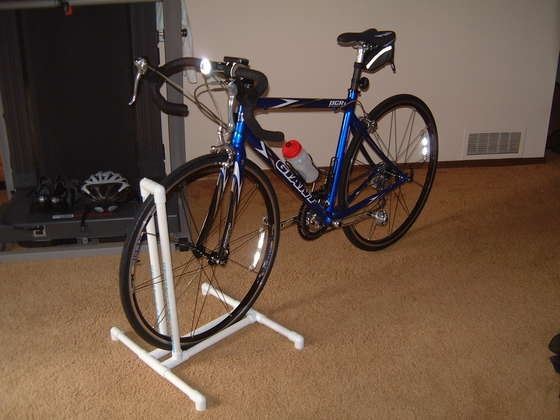I was moving the bikes from the garage to store outside with weather "proof" covers. So the kids can take a ride whenever they like without having adults to bring the bikes out of storage.
I was trying to work out the physics but got stuck on some points. So I built one base on other practical criteria but not on the absolute stability. It is based on the common 45 deg inclied design.
 |
| Inclined bike rack |
I shortened the top rail so the wheel rest tightly on the 45 deg slope, shorter than the diameter of the wheel. Like this, but the angle is 45 deg.
 |
| Wheel locked bike stand |
In doing so the centre of the wheel is moved away and down from the rack. But it turns out that the main instability comes from the centre of the wheel, trying to topple over to the sides. I was doing the opposite that is desirable, that the centre of the wheel (probably top of the wheel too) should be restricted by the stand as much as possible.
I was worry wrongly about that the front wheel will turn itself horizontally and so the whole bike become unstable. The front wheel does not have the tendency to turn, and friction make it difficult even if it wants to turn.
 |
| Vertical lock bike rack |
The other is the vertical design that use the top rail and one of the bottom rail to lock the wheel so the weight of the bike is on top of the stand. However, the vertical bar is too far from the centre and top of the wheel. You can see there are "wings" on the side for balancing.
 |
| Horizontal support bike rack |
There are horizontal designs that seem to use the weight of the bike. And the centre of the wheel is close to the stand, but not the top of the wheel. In any case it requires the kids to lift the wheel off the ground and onto the stand. May be just a little bit of lifting but rolling over a pipe is much easier.
 |
| Self-balancing bike stand |
My design turns out to be looking like a wheel clamp. The wheel must be standing on two lower points of the stand (A and B), not touching or barely touching the ground. Then a vertical bar raising up at an angle close to the centre and top of the wheel.
The stand, only about 5" wide (slightly wider than the length of two 3/4" tee couplings), is able to hold the bike vertical against strong wind without anything else. So I gave up the idea of a rack, allowing the kids to park anywhere they want, even carrying the stand along with a bike ride.
Point C doesn't do anything, not touching the wheel. It provide closure and support, otherwise the vertical bars on the two side of the wheel will be floating.
There is no need for exact dimensions, as long as the front wheel don't touch the ground. You can make the length A-B short enough to make sure of that. Short A-B doesn't lead to instability. The bike is very stable in that direction. You can also raise point B off the ground a bit to ensure that the wheel do not touch the ground. Or use thicker pipes than 3/4". You can also raise point A off the ground but the front wheel need to be lifted a bit to get into the stand, rather than roll over point A.
The gap between the bars is slightly thicker than the tires so the bike can get into and out of the stand freely. As of now, because the spokes near the centre are thicker than the tires, this is where the stand holds the bike in position. If that is not the case, the stand will hold the bike at the top of the wheel.
The perfect angle of the near vertical bars are just incidental. You just need to make it close to the centre of the wheel and the top of the wheel.
8 tee's and short pipes may be about $2 total.
You can put the bike on a thin wall.
I like these bike stands. They are good.
ReplyDelete